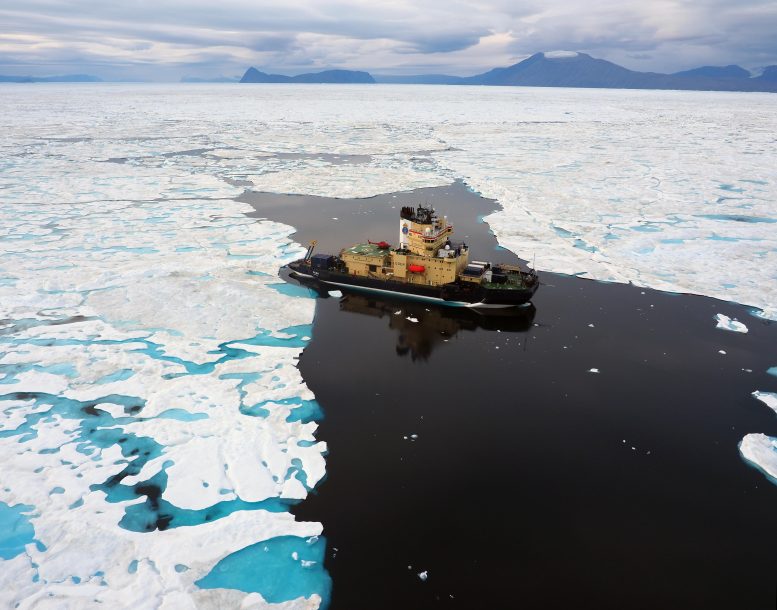
Icebreaker Oden in the sea ice north of Greenland. Credit: Martin Jakobsson, Stockholm University
New research indicates that summer Arctic Sea ice could soon become a relic of the past. Temperatures today mirror those of 10,000 years ago, when similar conditions led to the melting of this ice. The potential disappearance of this ice could have profound effects on both the climate and ecosystems.
In the face of escalating temperatures due to climate change, the “Last Ice Area” situated to the north of Greenland and Canada serves as the final refuge for perennial sea ice. However, recent research hints that this might not be the case for much longer.
A team of researchers from Aarhus University, working alongside Stockholm University and the United States Geological Survey, has managed to analyze samples from the previously unreachable region located north of Greenland.
“If we can keep temperatures stable or perhaps even make them fall, the sea ice would return to the area.” — Henrieka Detlef
The sediment samples were collected from the seabed in the Lincoln Sea, part of the “Last Ice Area.” They showed that the sea ice in this region melted away during summer months around 10,000 years ago. The research team concluded that summer sea ice melted at a time when temperatures were at a level that we are rapidly approaching again today.
“Climate models have suggested that summer sea ice in this region will melt in the coming decades, but it’s uncertain if it will happen in 20, 30, 40 years, or more. This project has demonstrated that we’re very close to this scenario and that temperatures only have to increase a little before the ice will melt,” says Christof Pearce, Assistant Professor at the Department of Geoscience, Aarhus University.
The researchers have used data from the Early Holocene period to predict when the sea ice will melt today. During this time period, summer temperatures in the Arctic were higher than today. Although this was caused by natural climate variability as opposed to human-induced warming, it still is a natural laboratory for studying the fate of this region in the immediate future.
In Aarhus, the marine samples have been analyzed in collaboration with Associate Professor Marianne Glasius and academic technical staff Mads Mørk Jensen from the Department of Chemistry. Among other things, they studied molecules from certain algae that are only produced when there is sea ice. The researchers can thereby determine when summer sea ice was present in the area.
A wake-up call
When the sea ice in the Lincoln Sea begins to melt during the summer months, it can have major consequences for the climate. Where white ice reflects the rays of the sun, a dark sea will absorb more than ten times as much solar energy and thereby increase global warming. Moreover, it can affect ecosystems:
“The sea ice is a base for many ecosystems. The algae we examined are food for fish, fish are food for birds, etc. How will the marine ecosystems be affected globally if the sea ice disappears? We don’t know the answer yet,” says Henrieka Detlef, an assistant professor at the Department of Geoscience.
According to the researchers from Aarhus University, the study can be interpreted as good and bad news for the climate.
“The bad news is that we can see this happening very soon. The good news is that our data shows the trend is reversible and we can do something about it if we reduce greenhouse gas emissions and set ambitious political goals. If we can keep temperatures stable or perhaps even make them fall, the sea ice would return to the area,” says Henrieka Detlef.
This is echoed by Christof Pearce: “The study is a wake-up call because we know that it will happen. This news is not making the situation more depressing, just more urgent. We have to act now so we can change it.”
Reference: “Seasonal sea-ice in the Arctic’s last ice area during the Early Holocene” by Henrieka Detlef, Matt O’Regan, Christian Stranne, Mads Mørk Jensen, Marianne Glasius, Thomas M. Cronin, Martin Jakobsson and Christof Pearce, 20 March 2023, Communications Earth & Environment.
DOI: 10.1038/s43247-023-00720-w
Funding: Aarhus Universitets Forskningsfond, Vetenskapsrådet, Horizon 2020 Framework Programme.

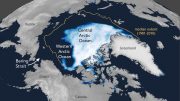

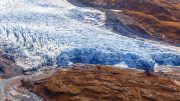
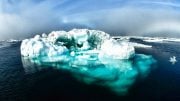


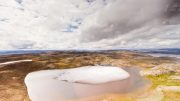

“Where white ice reflects the rays of the sun, a dark sea will absorb more than ten times as much solar energy and thereby increase global warming.”
I cannot find this claim in the actual research article. Perhaps the press-release writer decided to ‘improve’ upon the actual research. Be that as it may, someone took the liberty to add something that wasn’t in the published, peer-reviewed research. The problem is that the claim is not accurate. The claim of an order of magnitude increase in warming is based on the albedo of ice, and the combined specular reflectance of the water and the diffuse reflectance of suspended particles in the water, for high noon (when the sun is directly overhead). Unfortunately, the sun is NEVER directly overhead at 66 deg latitude and above; the most northerly the sun can be directly overhead is at the Tropic of Cancer (23.4° N lat). At the Equinox, the specular reflectance of water at 75 deg is about 11X that at the Equator at noon. During the Solstice, when the sun never sets, the specular reflectance varies between about 2X the reflectance at normal incidence, to about 50X (100%!) at the Terminator when the sun is on the horizon. That happens only one day out of the year. To properly calculate the warming impact, one has to integrate the hourly water-reflectivity over the ~6 months that the area inside the Arctic Circle is illuminated, also taking into account the longer path length, resulting in increased absorption and scattering. I’ll let those getting paid to do such things actually do it. Inasmuch as the specular reflectance of water at 75 deg N lat never gets below 20%, and can be as high as 100%, I’m confident that the ’10X’ claim is wrong.
https://wattsupwiththat.com/2016/09/12/why-albedo-is-the-wrong-measure-of-reflectivity-for-modeling-climate/
“The bad news is that we can see this happening very soon.”
How many times have predictions like this been made, and failed to happen? One should take the tale of “The Boy Who Cried ‘Wolf,'” to heart.
“The potential disappearance of this ice could have profound effects on both the climate and ecosystems.”
What were the long-term effects the last time it happened?
So they believe temperatures may rise to the Holocene Climate Optimum about 6000 years ago. Darn. There was still polar ice then, and we’d still be in the interglacial period of this ice age. Hard to know the last time there was no ice at the poles, 5 million years, 33 million, but definitely by 100 million, before it came back.
But apparently it’ll all be gone Really Soon Now. I’ll look forward to it, less articles like this one. If you believe, I’ve got some land in Antarctica to sell you, and sure, at the North Pole too, why not.
Most people in the world, particularly the narcissistic dreamers of the United States remain ignorant and asleep as they are going extinct. They are so deeply programmed with a belief that this world is somehow permanent and not transient. They believe that unbridled capitalism and unequal distribution of Earth’s resources to a vastly overpopulated world will magically continue forever. They are dead wrong. By 2030, we will be lucky if a single human remains on Earth. Climate change is now abrupt, exponential, and irreversible.
So we’ve only got 6 years left? Well, then at least we can agree there’s no point worrying.
So, you are going with the AOC prediction? Why not! Those kinds of belief systems are all pretty much the same. Except, that your deadline has a fatal flaw. There will still be a lot of people around who might remember the prediction and your credibility will be worthless for any updates. Actually, we should have a good idea of the reliability in two or three years because the system won’t fail catastrophically, unless Putin decides to launch a few H-bombs. But then it wouldn’t be climate change or capitalism that will be responsible.
BTW, Robert, you claimed that Climate Change is irreversible. However, you didn’t answer my question, “What were the long-term effects the last time it happened?”
I joke, because 79 months is absurd. Even if a 5kilometer-diameter asteroid made of COVID hits Yellowstone, it’s not half the doomsayer’s prediction. Still, some people are genuinely afraid. I worry what they’ll do irrationally, not just buying silly counterproductive battery cars, but what they’ll do to everyone else. There are powerful people taking advantage of that fear, directing it to their own ends. 2030 is too soon to have children and send them to school. 2030 is becoming panic. To quote Guinan, “When a man is convinced he is going to die tomorrow, he’ll probably find a way to make it happen”.
It doesn’t help if I answer your question, I know. This study estimated the early holoscene had only seasonal polar sea ice, and that might be true, so the long-term of climate change then was it started staying frozen year-round.
AOC, so she’s why I’m suddenly hearing 7 years lately. I’d bet she reconsiders in a few years. In the meantime, I’ll one-up her, and give the world 7 months until there’s no more ice anywhere. Prove me wrong December, prove me wrong.